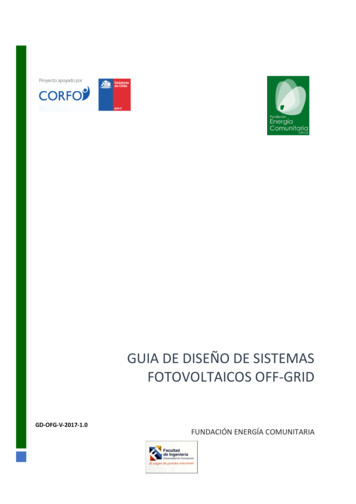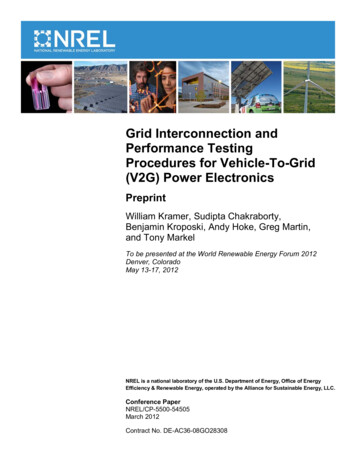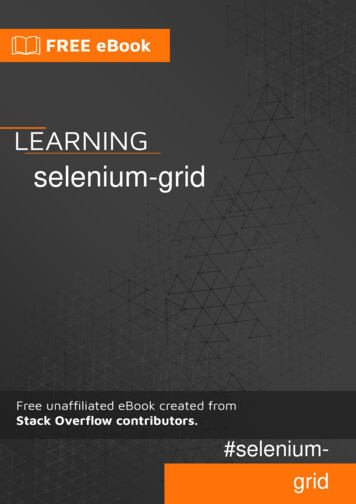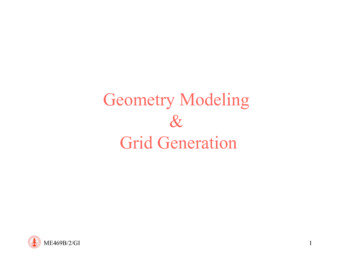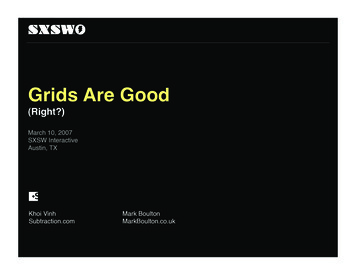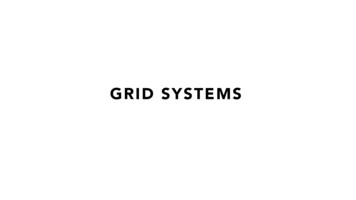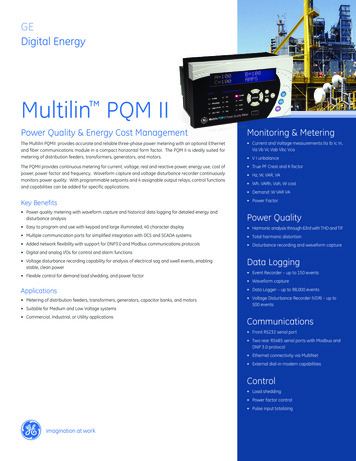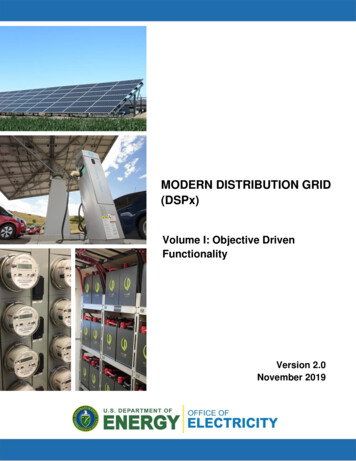
Transcription
MODERN DISTRIBUTION GRID(DSPx)Volume I: Objective DrivenFunctionalityVersion 2.0November 2019
ACKNOWLEDGEMENTSModern Distribution Grid Report, Volume I was sponsored by the U.S. Department of Energy’s(DOE) Office of Electricity (OE) and the Office of Energy Policy and Systems Analysis (EPSA).This report was originally developed at the request and with guidance from the California PublicUtilities Commission (CPUC), New York Public Service Commission (NYPSC), District ofColumbia Public Service Commission (DCPSC), Hawaii Public Utilities Commission (HPUC) andMinnesota Public Utilities Commission (MPUC). This update developed in Phase 2 has benefitedfrom regulatory and industry insights and feedback drawn from practical use of the original versionin over 20 states. Specifically, this revision draws from engagement with the New England Councilof Public Utility Commissions (NECPUC) and their members, and the Public Utility Commissionof Ohio, as well as reviews with the Maryland Public Utility Commission, Michigan Public ServiceCommission, Missouri Public Utilities Commission, National Association of Regulatory UtilityCommissioners, and the North Carolina Utility Commission.Project TeamThe project lead is Joe Paladino, a Technical Advisor within the DOE-OE’s TransmissionPermitting and Technical Assistance Division. Phase 1 was co-led by Merrill Smith, a ProgramManager for DOE-OE, and Thomas Pearce, a Senior Policy Advisor within the DOE-EPSA Officeof State, Local, and Tribal Policy Analysis. The co-project managers of the next generationdistribution system platform (DSPx) initiative are Paul De Martini, Newport Consulting, and JeffreyTaft, Pacific Northwest National Laboratory (PNNL).The original volume and this revision were collectively developed by Paul De Martini; Jeff Taft;the ICF team of Patricia D’Costa, Brenda Chew, Surhud Vaidya, Don Mak and Annie Howley; andDonna Attanasio of the Energy Law Programs at George Washington University.MODERN DISTRIBUTION GRID: VOLUME I 1
ContributorsThe Modern Distribution Grid project team would also like to thank industry experts from thefollowing organizations for support in the development of the original version of Volume I or thisrevision: Advanced Microgrid SolutionsAmerican Electric PowerArara Blue EnergyArizona Public Service (APS)AVANGRIDCalifornia Energy Commission(CEC)California Independent SystemOperator (CAISO)CDNudsen AssociatesCenterpoint EnergyCentral HudsonConsolidated EdisonConsortium for Energy PolicyResearch, Harvard Kennedy SchoolConsumers EnergyDominionDuke EnergyEatonElectric Power Research Institute(EPRI)EnbalaEnergyHubElectric Reliability Council of Texas(ERCOT)ETAPEdison Electric Institute (EEI)Flathead Electric Co-operativeGeneral Electric (GE)Hawaiian Electric Company (HECO)IEEEIntegral AnalyticsLandis GyrLawrence Berkeley National Lab(LBNL)Lawrence Livermore National Lab(LLNL)National Grid National Renewable Energy Lab(NREL) New York Battery & Energy StorageTechnology New York Independent SystemOperator (NYISO) New York State Energy Researchand Development Authority(NYSERDA) National Rural Electric CooperativeAssociation (NRECA) North Carolina State University NRG Energy Pacific Gas & Electric (PG&E) Pacific Northwest NationalLaboratory (PNNL) PJM Interconnection Sandia National Laboratory Siemens Smart Grid Interoperability Panel(SGIP) Southern California Edison (SCE) Southern Company San Diego Gas & Electric (SDG&E) SLAC National AcceleratorLaboratory Smarter Grid Solutions US Department of EnergyMODERN DISTRIBUTION GRID: VOLUME I 2
DISCLAIMERThis report was prepared as an account of work sponsored by an agency of the United StatesGovernment. Neither the United States Government nor any agency thereof, nor any of theiremployees, makes any warranty, express or implied, or assumes any legal liability orresponsibility for the accuracy, completeness, or usefulness of any information, apparatus,product, or process disclosed, or represents that its use would not infringe privately owned rights.Reference herein to any specific commercial product, process, or service by trade name,trademark, manufacturer, or otherwise, does not necessarily constitute or imply its endorsement,recommendation, or favoring by the United States Government or any agency thereof. The viewsand opinions of authors expressed herein do not necessarily state or reflect those of the UnitedStates Government or any agency thereof.COVER PHOTO CREDITSTop: The Ántukš-Tińqapapt or “sun trap” solar array recently installed by the Confederated Tribesof the Umatilla Indian Reservation in Oregon. Courtesy of the U.S. Department of Energy.Middle: NREL-owned electric vehicles below solar canopy at the Vehicle Testing & IntegrationFacility. Courtesy of the U.S. Department of Energy.Bottom Left: Smart Meters in Washington, DC. Photo by Patricia D'Costa. Courtesy of ICF.Bottom Right: Lotus Energy designed a solar plus storage system. Photo by Christine Bennett.Courtesy of the U.S. Department of Energy.
TABLE OF CONTENTSIndustry Definitions . 7Technology Definitions . 9Purpose . 10Approach and Organization . 11Taxonomy Framework . 131.1 State Objectives . 161.1.1 Overview and Purpose . 161.1.2 Methodology. 171.1.3 Objectives . 191.1.4 Key Findings . 20OVERVIEW . 222.1 DISTRIBUTION SYSTEM PLANNING . 232.1.1. Scalability . 232.1.2 Impact Resistance and Resiliency . 232.2.3Open and Interoperable . 232.2.4 Accommodate Technological Innovation . 232.2.5 Convergence with Other Critical Infrastructures . 232.2.6 Accommodate New Business Models . 232.2.7 Transparency . 232.2. DISTRIBUTION GRID OPERATIONS . 242.2.1 Operational Risk Management . 242.2.2 Situational Awareness . 242.2.3 Controllability and Dynamic Stability . 24MODERN DISTRIBUTION GRID: VOLUME I 3
2.2.4Management of DER and Load Stochasticity . 242.2.5Contingency Analysis . 252.2.6Security . 252.2.7Public and Workforce Safety . 252.2.8Fail-Safe Modes . 252.2.9Attack Resistance / Fault Tolerance / Self-Healing . 252.2.10Reliability and Resiliency Management . 252.2.11Integrated Grid Coordination . 262.2.12Control Federation and Control Disaggregation . 262.2.13Privacy and Confidentiality . 262.2.14Flexibility . 262.2.15Workforce Management . 262.3 DISTRIBUTION MARKET OPERATIONS. 272.3.1Distribution Investment Optimization . 272.3.2Distribution Asset Optimization . 272.3.3Market Animation . 272.3.4System Performance . 272.3.5Environmental Management . 272.3.6Local Grid Optimization . 272.4 OBJECTIVES TO CAPABILITIES MAPPING . 28OVERVIEW . 303.1 DISTRIBUTION SYSTEM PLANNING . 313.1.1Short and Long-term Demand and DER Forecasting . 313.1.2Short-term Distribution Planning . 313.1.3Long-term Distribution Planning . 323.1.4Interconnection Process . 323.1.5Reliability and Resiliency Criteria . 323.1.6Locational Value Analysis . 323.1.7Integrated Resource Transmission and Distribution Planning . 333.1.8Distribution System Information Sharing . 33MODERN DISTRIBUTION GRID: VOLUME I 4
3.1.9Planning Analytics . 333.1.10Hosting Capacity Analysis . 333.1.11EV Readiness . 343.2 DISTRIBUTION GRID OPERATIONS . 343.2.1Observability (Monitoring & Sensing) . 343.2.2Distribution Grid Control . 343.2.3Asset Optimization . 353.2.4Integrated Operational Engineering and System Operations . 353.2.5Distribution System Representation . 353.2.6Distribution to Transmission Operational Coordination . 353.2.7Power Quality Management . 353.2.8DER Operational Control. 353.2.9Cybersecurity . 353.2.10Physical Security . 363.2.11Operational Information Management . 363.2.12Reliability Management . 363.2.13Operational Forecasting . 363.2.14Operational Analysis . 363.2.15Microgrid Management . 363.2.16Threat Assessment and Remediation . 373.2.17Operational Telecommunications . 373.2.18Customer Information . 373.2.19Distribution to Customer / Aggregator Coordination . 373.3 DISTRIBUTION MARKET OPERATIONS. 383.3.1DER Aggregation to Distribution and/or Wholesale Market . 383.3.2Solution Sourcing . 383.3.3Solution Evaluation. 393.3.4Market Information Sharing . 393.3.5Market Oversight . 393.3.6Solutions Portfolio Optimization . 393.3.7Advanced Pricing . 39MODERN DISTRIBUTION GRID: VOLUME I 5
3.3.8Programs. 393.3.9Market Participant Rules . 393.3.10Market Clearing & Settlement .
distribution system platform (DSPx) initiative are Paul De Martini, Newport Consulting, and Jeffrey Taft, Pacific Northwest National Laboratory (PNNL). The original volume and this revision were collectively developed by Paul De Martini; Jeff Taft; the ICF team of Patricia D’Costa, Brenda Chew, Surhud Vaidya, Don Mak and Annie Howley; and Donna Attanasio of the Energy Law Programs at George .
